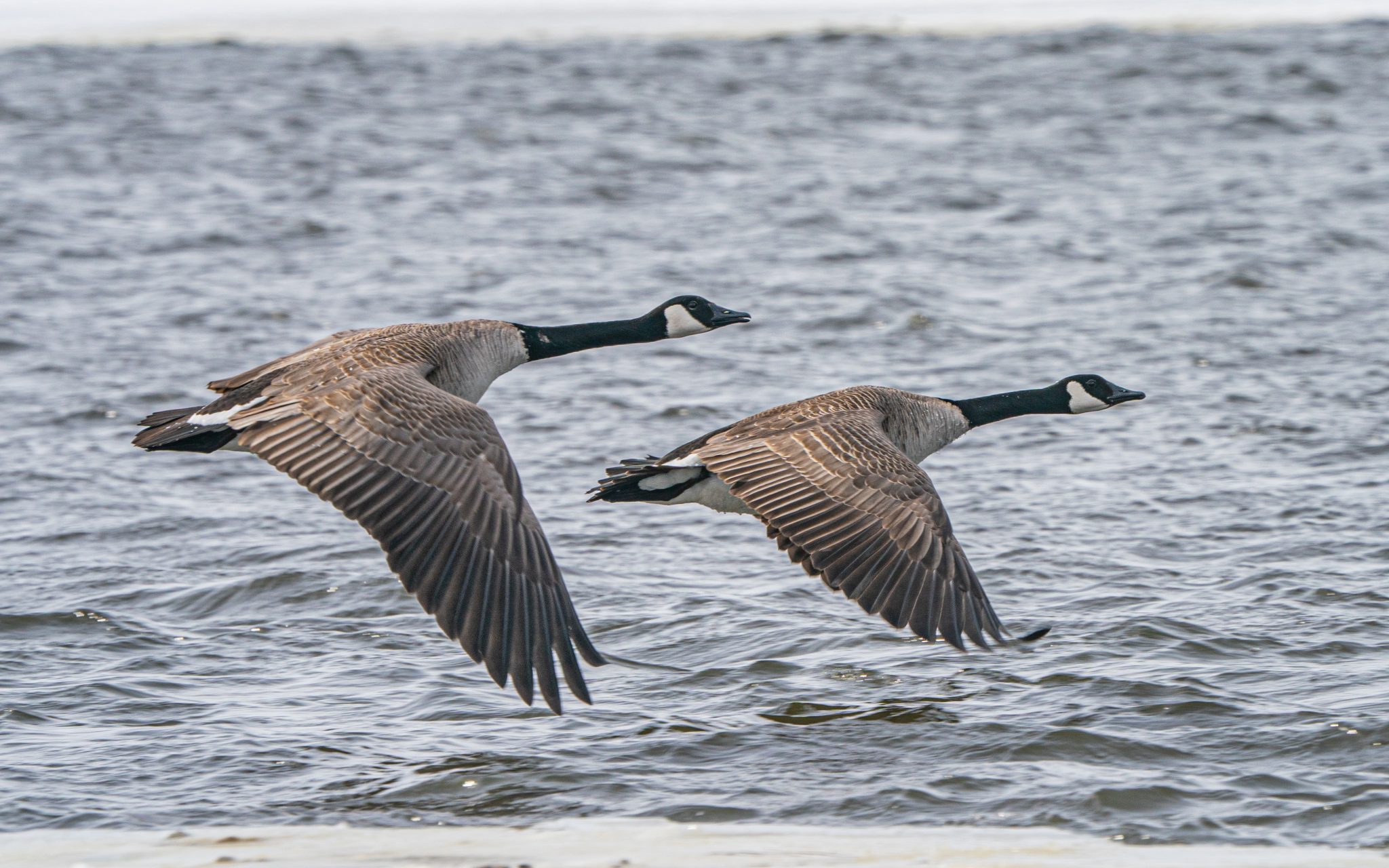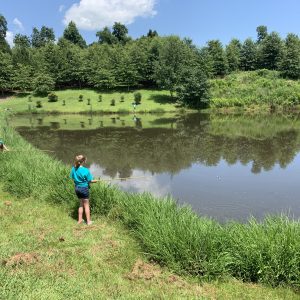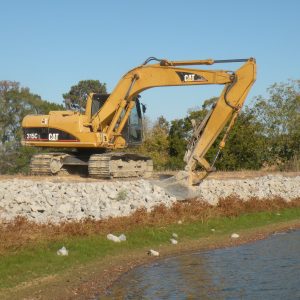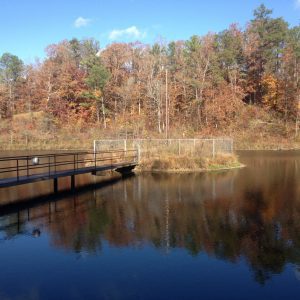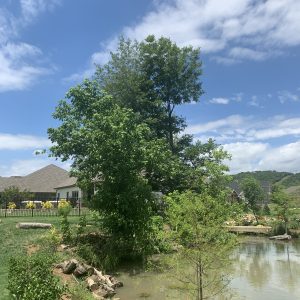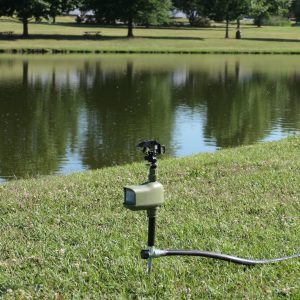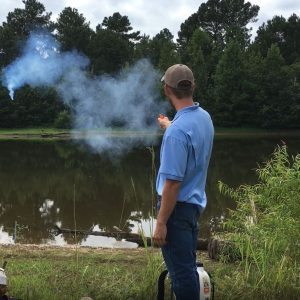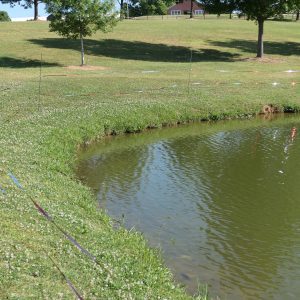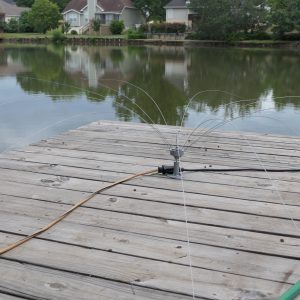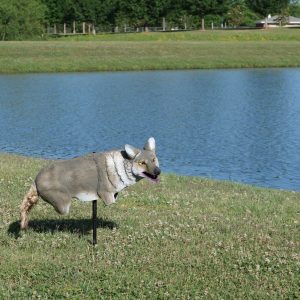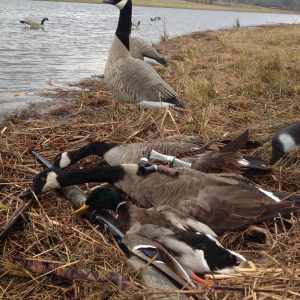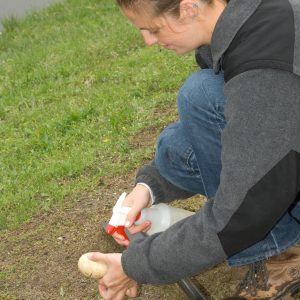Forestry & Wildlife

Canada geese can quickly become a nuisance to those living and working near ponds and other water sources. Knowing the options and regulations for managing and controlling their presence can help to keep these prolific waterfowl at bay.
Canada geese (Branta canadensis) are a common sight in and around many farm and neighborhood ponds, golf courses, and parks across Alabama. Yet this was not always the case. In the early 20th century, Canada geese were eradicated from much of the United States due to unregulated hunting and habitat loss.
Beginning in the 1950s and accelerating into the 1980s, many southern states received Canada geese from northern states hoping to reestablish Canada goose hunting. Restocking efforts were highly successful and were stopped by the early 1990s due to expanding populations.
The total population of Canada geese is estimated at more than 4 million birds and is made up of both migratory and resident (nonmigrating) populations. Migratory Canada geese primarily nest in Canada and Alaska and travel south for the winter; resident geese nest and stay in the lower 48 states throughout the spring and summer. Due in part to their adaptability and extensive use of suburban and urban landscapes, resident populations have exploded to a level of nuisance, now near 2.8 million birds in the lower 48 states.
Damage
Professionals stress that resident geese are not just lazy migrating geese that stopped migrating. Resident geese need to be managed differently because of their higher population growth rates.
Canada geese use suburban and urban areas due partly to the lack of hunting pressure and predators and the abundance of suitable habitats. They are attracted to the ample manicured grass and supplemental feed placed by some well-intentioned people and to the abundant number of ponds. One study from Georgia reported an annual survival rate of around 95 percent for adult resident Canada geese in urban and suburban areas. This high survival rate coupled with abundant resources can lead to overpopulation and nuisance problems in a short amount of time.
Geese emit a large amount of fecal material that can contaminate water sources and cause a mess in parks, beaches, golf courses, and lawns where it accumulates. The high-nutrient feces can degrade water quality, cause fish deaths, and create significant aquatic weed problems. Geese overgraze manicured turf grass, which causes dead spots in lawns and golf courses. Other problems caused by geese include aggressive behavior toward people and pets, agricultural crop damage, noise pollution, and aircraft collisions. One of the most well-known collisions occurred in 2009 when US Airways Flight 1549 hit a flock of birds and eventually landed on the Hudson River. This landing became known as the Miracle on the Hudson.
Regulations
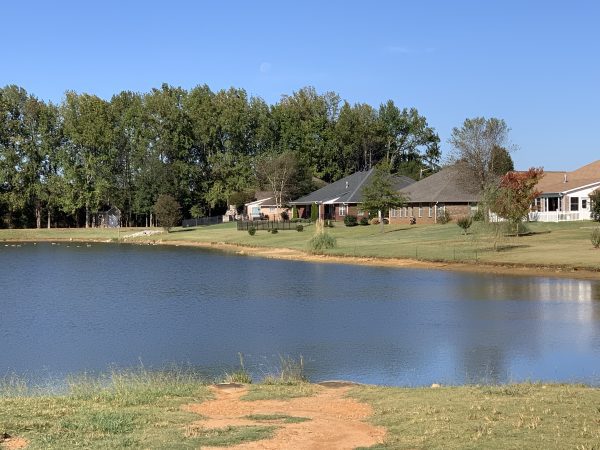
Figure 1. Well-manicured shorelines with gradual slopes are ideal for waterfowl. They allow birds to easily exit and enter the water to use the surrounding turf for feeding and loafing.
Like all waterfowl, both migratory and resident Canada geese populations are protected by the Migratory Bird Treaty Act (MBTA) of 1918. This regulation prohibits disturbing and destroying active nests and eggs and makes it illegal to shoot geese outside regulated hunting seasons. The act also prohibits the taking (defined as killing, capturing, selling, trading, and transporting) of migratory birds without prior permission from the U.S. Fish and Wildlife Service (USFWS).
Permission to hunt within designated seasons requires the purchase of a Federal Duck Stamp and necessary state hunting licenses. USFWS authorizes states to issue depredation permits when conflicts occur with geese, private property, agricultural commodities, and health and human safety.
Prevention
The best option to prevent Canada geese from becoming a problem is to use a proper pond design. This involves managing the pond for vegetation that geese find unattractive for feeding and loafing or limits their shoreline access.
Canada geese are drawn closer to human populations because many new home developments include one or a series of retention or detention ponds to handle runoff from impervious surfaces. This arrangement fosters flocks of Canada geese since they prefer to land in water and walk up to open areas with short grass to feed (figure 1).
Following are design features that are less attractive to geese and deter them from frequenting a pond:
- A retention or detention pond with the smallest surface area possible to still meet water control needs
- Steep, sloping banks that make it difficult for geese to enter and exit the water
- Tall grass along the edge of the pond (figure 2)
- A riprap border (figure 3)
- Shrubbery planted every 10 to 20 yards
- Elimination of islands or peninsulas, which are attractive nesting areas (figure 4)
- Trees planted in the flight path (figure 5)
- Figure 2. Allowing grass to grow tall along the edge of a pond deters geese.
- Figure 3. Marginal plantings, grass buffers, and riprap along the water’s edge disrupt waterfowl access to turf used for feeding and loafing.
- Figure 4. Avoid islands and peninsulas during construction. Here the pond owner has gone as far as installing a chain link fence to exclude persistent nesting geese.
- Figure 5. This shoreline has grown in native vegetation, and logs have been placed at the water’s edge to reduce waterfowl access.
Control Techniques
When geese (or any waterfowl) frequent an area, the first step is to remove all supplemental feed, such as bird or fish feeders, and discourage anyone from feeding the geese.
Exclusion
Exclusion devices, such as an overhead wire grid, plastic balls, and fencing, can exclude or deter geese from utilizing a pond. A grid of monofilament or stainless-steel wires suspended above the pond works to prevent geese from landing on or taking off from the water; however, this is not a practical method on larger ponds.
Bird balls (4-to-6-inch hollow, black plastic balls) can be added to a pond to cover the surface and prevent geese from accessing open water. This may be an option in retention ponds where aesthetics is not as important.
Wire or electric fences can be constructed at the water’s edge to prevent geese from walking out of the water onto the grass. Fences work best during the flightless molt stage in the summer months. When building a fence in public areas, use a welded wire mesh at least 30 inches tall with openings of 2 inches by 4 inches or less. Other fencing options include plastic, silt, or nylon; while cheaper, these fences will not last as long.
Low-voltage electric fences that consist of either two or three wire strands placed at 8 inches and 16 inches, or 5 inches, 10 inches, and 15 inches above the ground can work well and are easily set up and taken down. Low-voltage fences provide stimulation that geese will avoid, but they should not be used in areas where human and pet access cannot be controlled. Note: Electricity and water do not mix; consult a professional before using an electric fence near your pond.
Hazing
Hazing is a category of nonlethal methods that scare geese away from a particular site. It is most effective when used before geese have imprinted on an area and a significant nuisance occurs. Hazing options come in several categories and require varying effort, cost, and monitoring.
Canada geese can become habituated to most all hazing techniques. It is essential to understand that hazing efforts must be consistent to remain effective, but the methods used must be varied with a mix of deterrents, such as the following:
Battery-powered, motion-activated sprinklers. When triggered, these devices spray a strong stream of water (figure 6). For maximum efficiency, sprinklers should be adjusted for sensitivity, spray height, and coverage. They can easily be moved around, so flocks do not become accustomed to them.
Auditory tools. Automatic propane cannons and pyrotechnics emit a loud sound that frightens geese (figure 7). Note: auditory hazing devices may not be suitable near residential areas. Other devices distort geese calls or emit distress calls that cause the animals to leave the area. However, prolonged, repeated use of any one technique will see a decline in effectiveness. Instead, varying the hazing used weekly will better deter and maintain control.
- Figure 6. Motion-activated sprinklers are a quick, easy, and cost-effective tool to deter geese.
- Figure 7. Consistent and persistent use of pyrotechnics, such as this handheld Bird Banger, can be used safely and accurately to disrupt and discourage waterfowl by nonlethal means.
Visual frightening devices. These can be used to make geese uncomfortable and deter them from utilizing the area:
- Reflective Mylar tape or streamers flutter in the wind and erratically reflect the sunlight. They can be easily tied onto posts or a string stretched near the water’s edge (figure 8). These items exploit neophobia, or fear of new things, to keep geese away.
- Spider-like devices, such as the Daddi Long Legs or Bird Spider 360, have weighted wires on a rotating axis that move with the wind. They can effectively deter geese from specific locations such as docks (figure 9), boats, and boathouses.
- Strobe lights emit bright light in an erratic pattern and can successfully make the geese uncomfortable.
- Predator decoys, such as coyote silhouettes (figure 10), artificial alligator heads that float, and balloons that mimic predators’ eyes, are also helpful. Whatever the decoy used must be frequently moved around; otherwise, waterfowl become quickly habituated to it as they realize there is no threat.
- Figure 8. Reflective objects, such as Mylar tape, pie pans, and CDs, can be strung along the pond edge to deter and disrupt waterfowl access.
- Figure 9. Devices, such as the Daddi Long Legs or Bird Spider 360, have weighted wires that bob and rotate in the wind. Sizes vary and range from 4 to 8 feet in diameter.
- Figure 10. Predator decoys should be as lifelike as possible. For example, a cloth tail that moves in the wind or a decoy that swivels on a stake can increase decoy efficacy.
Specially trained dogs, typically border collies. These dogs are trained not to attack but to chase geese away. Businesses that specialize in herding dogs can be hired for use on golf courses and in suburban and urban areas where visual or auditory hazing methods could draw complaints from residents.
Chemical repellants. Repellants with the active ingredient anthraquinone or methyl anthranilate can be used to deter Canada geese from feeding on grasses. Anthraquinone is a naturally occurring plant compound that deters birds from consuming it. Methyl anthranilate is another naturally occurring chemical that makes grass unpalatable to geese. These repellents are expensive, relatively short-lived, and only effective when properly applied to grass that geese are consuming. Chemical repellants are not a one-stop solution but can be an addition to a nuisance geese control program.
Trapping
When Canada goose damage occurs, trapping and relocating nuisance flocks is often the first control idea considered, but research shows mixed results. Since female geese have high site fidelity in nesting, they may return in subsequent years. Another problem with trapping and relocating is the time and financial costs involved. When combining these factors with trying to find a receptor site, few states do any trapping and relocating of nuisance Canada geese; instead, geese are trapped and euthanized.
Lethal Control Options
When allowed by law, lethal control options have been an effective tool to help manage populations. Use of these options requires a Federal Duck Stamp or depredation permit from the Fish and Wildlife Service, depending on the method used.
Legal hunting within designated seasons, such as the initial period of Alabama’s goose hunting season, does well to target resident Canada goose populations and reduce damage before any migratory geese arrive (figure 11). Geese do not tolerate hunting pressure and often move quickly to other areas when confronted with hunting.
The early portion of the goose season currently includes September and the first two weeks in October. Check outdooralabama.com for current seasons and bag limits, as they change annually. Also, check local laws and regulations that may limit firearm use within city limits.
Other lethal control methods target nests in March or April and require a permit. These methods can prevent hatching, stabilize populations, and reduce impacts from goslings, but they should not be the sole method used.
- Figure 11. When and where possible, legal hunting during regulated waterfowl seasons does well to deter waterfowl damage as flocks do not tolerate hunting pressure and will seek other areas. Check with your local Alabama Department of Conservation and Natural Resources for the rules and regulations for hunting waterfowl in Alabama.
- Figure 12. A thin coating of vegetable oil is applied to the egg, rendering it unviable. The eggs are left in the nest to reduce the chance of renesting. Permits can be obtained from the Fish and Wildlife Service (FWS) to destroy nests or eggs. (Photo credit: USDA APHIS Wildlife Services)
Nests and eggs can be physically destroyed, but renesting may occur. The best practice is to render the eggs unviable by puncturing, oiling, or addling. However, the eggs should be left in the nest to trick the goose into continuing to incubate the nest and not to renest.
Puncturing is done using a small, sharp tool or wire to create a hole in the egg and then stir the contents. Egg addling is a labor-intensive process where each egg is shaken for 5 to 10 minutes and placed back in the nest. Oiling applies a thin layer of vegetable oil to the egg, thereby suffocating the embryo (figure 12). Oiling is typically the method of choice. Watch for the adults while working around the nest as they may become aggressive.
To obtain an annual permit to destroy a Canada goose nest or eggs, visit the United States Fish and Wildlife Service website at www.fws.gov, Resident Canada Goose Registration page. Depredation permits can be obtained from the U.S. Fish and Wildlife Service to destroy the nests or eggs of geese when significant risk or damage to human health or property occurs.
Euthanasia is the final lethal control option available. This involves either specially trained sharpshooters to shoot geese or personnel that trap flightless birds before euthanizing the flock. USDA Wildlife Services typically do this. Euthanasia can be used in conjunction with fencing and is most effective during the flightless molting period.
Resources
- Department of Conservation and Natural Resources Wildlife and Freshwater Fisheries District Offices
- Department of Conservation and Natural Resources Permitted Nuisance Wildlife Control Operators
- “Management of Canada Goose Nesting,” USDA Wildlife Services
- Preventing and managing waterfowl damage. USDA Wildlife Services.
 J. Ryan Mitchell, Regional Extension Agent; Norm Haley, Regional Extension Agent, and Wesley Anderson, Extension Specialist, Assistant Professor, all in Forestry, Wildlife and Natural Resources with Auburn University
J. Ryan Mitchell, Regional Extension Agent; Norm Haley, Regional Extension Agent, and Wesley Anderson, Extension Specialist, Assistant Professor, all in Forestry, Wildlife and Natural Resources with Auburn University
New August 2022, Canada Geese Management and Control, FOR-2120

